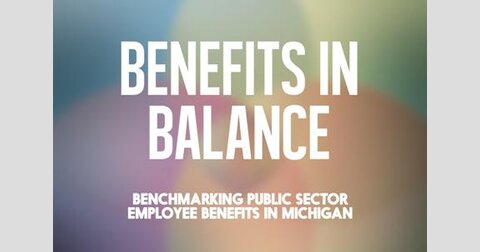State Workers Earn $5.8 Billion More in Benefits Than Private Sector Employees
New study shows that while the state's population, GDP and income fell, government worker benefits skyrocketed
In Michigan, the difference in benefits between state and local government workers and the average taxpayer who supports them is $5.8 billion per year, according to a new study.
If the state eliminated that discrepancy, the Michigan income tax could be cut in half and there still would be money left over.
Larger demands from pension funds and ever-increasing insurance premiums have been blamed for local government fiscal stress, but few citizens realize how big the gap truly is between private and public sector workers. And as compensation costs for government workers has increased much faster than the average taxpayers' has, money has been taken away from some of the things government is supposed to be doing.
The study from the Mackinac Center for Public Policy is important because the cost of benefits for public employees has skyrocketed to the point that they are squeezing the private sector and other government services. From 2000 to 2010, Michigan’s population fell 1 percent, K-12 enrollment dropped 6 percent, violent crime fell by 12 percent, property crime fell by 24 percent, and GDP and personal income increased by only 9 percent and 16 percent respectively. Inflation was 27 percent.
At the same time, private sector employment fell 17 percent (to 3.86 million jobs from 4.68 million jobs) while state and local government employment fell by about 7 percent. The average salary of public employees roughly kept pace with inflation.
But the costs of public benefits skyrocketed. Total spending in this area increased about 60 percent over the decade.
In Detroit and cities around the state, these costs have meant layoffs in police, fire departments, and less money for infrastructure.
"The more government spends on these benefits, the less it can spend providing services to Michigan residents," wrote James Hohman, a fiscal policy analyst at the Mackinac Center, and author of the study. "Benchmarking these costs to more closely resemble private sector averages would do much to free up cash to support government services and allow taxpayers to keep more of their own resources."
The study measures all government workers, from the state level down to local townships and schools and state workers at community colleges and state universities. The study only looks at the costs of benefits, which tend to be offered to employees on a more uniform basis than salary (for example, the CEO of a private company or department head of a government agency tend to get the same health insurance as everyone else).
Here are the areas and the estimated annual savings to the state by right-sizing the benefits:
Health insurance: $3.24 billion. The largest gap between the private and public-sector, by far. Private sector workers have health insurance plans with lower cost premiums and pay a higher percentage of them. The study notes that in 2011, the average family health plan cost school districts $17,692, while the average private sector plan cost businesses $10,988.
Retirement benefits: $1.46 billion. The state has consistently underfunded its pension plans, causing these costs to soar. A 1997 reform began transitioning state workers to a defined contribution plan, saving billions. The study recommends shifting school district and other employees to 401(k)-type plans, like state employees and the vast majority of those in the private sector.
Paid leave: $1.14 billion. Taxpayers provide public employees much more generous paid leave for vacation time, sick leave and other time off, costing over a billion dollars a year.
Government workers aren't better off in every area, however. The study found that private-sector workers receive more "nonproduction bonuses," which is payment for things like Christmas bonuses and company stock. The difference is an advantage of $84 million for the private sector employees.
Many of these extra benefits for government workers are set at the local level, and some recent reforms have taken place that aim to help benchmark these costs. But the study offers some more options:
- Continue and expand programs that give local governments the financial incentive to reduce the costs of their employees' benefits through additional revenue sharing.
- Mandate limits to the amount schools districts and local governments will pay for benefits. This is now done for health care costs. It could be done in other areas.
- Introduce a constitutional amendment to be put to voters, "which would mandate that state and local government employees not receive benefits that exceed certain private sector averages."
"Bringing benefits into balance will go a long way to fixing the government cost spiral, where governments spend more and more every year to provide the same services," Hohman said.
~~~~~
A video about the study:
Michigan Capitol Confidential is the news source produced by the Mackinac Center for Public Policy. Michigan Capitol Confidential reports with a free-market news perspective.


 Michigan health employee approved, denied benefits without interviews
Michigan health employee approved, denied benefits without interviews
 Michigan Legislature approves bill to extend, boost unemployment benefits
Michigan Legislature approves bill to extend, boost unemployment benefits